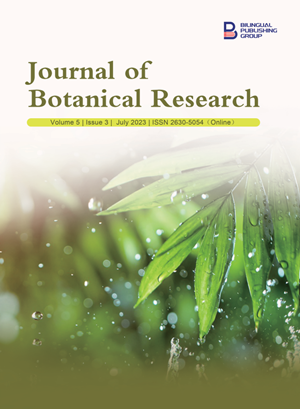-
245
-
208
-
170
-
159
-
142
Species Distribution and Patterns in a Forest-savannah Ecotone: Environmental Change and Conservation Concerns
DOI:
https://doi.org/10.30564/jbr.v5i3.5588Abstract
Understanding the dynamics and patterns of biodiversity in transition forests is vital in promoting conservation and addressing environmental change issues. This work focused on elucidating the diversity, structure, and carbon potentials of a forest-savannah ecosystem. To achieve this, 8 forest plots that measured 50 m × 50 m each was set up in a forest-savannah landscape and used to identify and measure tree species ≥ 10 cm diameter at breast height (DBH measured at 130 cm). Species importance value was used to summarize the biodiversity patterns and the aboveground carbon estimates were elicited with the allometric equation. 43 species within 22 families were enumerated and the diversity was generally low (ranging from 1.82-2.5). Species such as Daniellia oliveri (Rolfe) Hutch. & Dalziel, Pyrostria guinnensis Comm. ex A. Juss, Dialium guineense Willd. and Margariteria discoidea (Baill.) G.L Webster were the dominant species, and had the highest importance values of 113.06, 55.13, 28.16 and 16.95, respectively, while Allophlus africanus P. Beauv., Annona senegalensis Pers., Anthonatha macrophylla P. Beauv., Ficus capensis Thumb. and Lecaniodiscus cupanioides Planch had the least importance values of 0.16 each. Carbon estimates ranged from 16.43172-42.9298 t/Ha. Most frequent species with higher basal areas no doubt contributed much to the carbon estimates, but did not have higher capacities in storing carbon. Managing the ecosystem with more carbon-dense species was seen as a suitable strategy for addressing environmental change in the ecosystem and region.
Keywords:
Biodiversity; Carbon potentials; Climate change; Ecosystem conservation; Land use changeReferences
[1] Pan,. Y., Birdsey, R.A., Fang, A., et al., 2011. A large and persistent carbon sink in the world’s forests. Science. 333, 988-993.
[2] Erb, K.H., Kastner, T., Plutzar, C., et al., 2018. Unexpectedly large impact of forest management and grazing on global vegetation biomass. Nature. 553(7686), 73-76.
[3] Gaviria, J., Turner, B.L., Engelbrecht, B.M.J., 2017. Drivers of tree species distribution across a tropical rainfall gradient. Ecosphere. 8(2), e01712. DOI: https://doi.org/10.1002/ecs2.1712
[4] Chase, J.M., 2014. Spatial scale resolves the niche versus neutral theory debate. Journal of Vegetation Science. 25(2), 319-322.
[5] Richards, P.W., 1952. The tropical rain forest: An ecological study. Cambridge University Press: Cambridge. pp. 450.
[6] Keay, R.W., 1959. An outline of the Nigerian vegetation. Federal Department of Forest Research. Federal Ministry of Information: Lagos.
[7] Igbozurike, M.U., 1975. Vegetation types. Nigeria in maps: Eastern States. Ethiope Publishing House: Benin. pp. 30-31.
[8] Ofomata, G.E.K., 1975. Vegetation types and soils. Nigeria in maps: Eastern states. Ethiope Publishing House: Benin. pp. 30-45.
[9] Keay, R.W.J., 1989. Trees of Nigeria. Clarendon Press: Oxford.
[10] Plant List Version 1.1 [Internet]. The Plant List; 2013. Available from: http://www.theplantlist.org/
[11] Cottam, G., Curtis, J.T., 1956. The use of distance measurements in phytosociological sampling. Ecology. 37(3), 451-460.
[12] Kent, M., Coker, P., 1992. Vegetation description analysis. Wiley: Chichester.
[13] Chave, J., Réjou-Méchain, M., Burquez, A., et al., 2015. Improved allometric models to estimate the aboveground biomass of tropical trees. Global Change Biology. 20(10), 3177-3190. DOI: https://doi.org/10.1111/gcb.12629
[14] Ndah., N.R., Andrew, E.E., Bechem, E., 2013. Species composition, diversity and distribution in a disturbed Takamanda Rainforest, South West, Cameroon. African Journal of Plant Science. 7(12), 577-585. DOI: https://doi.org/10.5897/AJPS2013.1107
[15] Gentry, A.H., 1988. Changes in plant community diversity and floristic composition on environmental and geographical gradients. Annals of the Missouri Botanical Garden. 75, 1-34. DOI: https://doi.org/10.2307/2399464
[16] Hoffmann, W.A., Jaconis, S.Y., Mckinley, K.L., et al., 2012. Fuels or microclimate? Understanding the drivers of fire feedbacks at savanna-forest boundaries. Austral Ecology. 37(6), 634-643.
[17] Ibanez, T., Hély, C., Gaucherel, C., 2013. Sharp transitions in microclimatic conditions between savanna and forest in New Caledonia: Insights into the vulnerability of forest edges to fire. Austral Ecology. 38(6), 680-687.
[18] Lewis, S.L., Sonké, B., Sunderland, T., et al., 2013. Aboveground biomass and structure of 260 African tropical forests. Philosophical Transactions of the Royal Society B. 368, 20120295.
[19] Terra, M.N.S., do Prado-Júnior, J.A., de Souza, C.R., et al., 2021. Tree species dominance in neotropical savanna aboveground biomass and productivity. Forest Ecology and Management. 496, 119430.
[20] Chase, M.W., Christenhusz, M.J.M., Fay, M.F., et al., 2016. An update of the Angiosperm Phylogeny Group classification for the orders and families of flowering plants: APG IV. Botanical Journal of the Linnean Society. 181(1), 1-20.
[21] Baptista, M.S.P., Assunção, V.A., Bueno, M.L., et al., 2020. Species representativeness of Fabaceae in restrictive soils explains the difference in structure of two types of Chaco vegetation. Acta Botanica Brasilica. 34(3), 559-569.
[22] Gentry, A.H., 1995. Diversity and floristic composition of Neotropical dry forests. Seasonally dry tropical forests. Cambridge University Press: Cambridge, UK. pp. 146-194.
[23] Lima, J.R., Tozzi, A.M., Mansano, V.F., 2015. A checklist of woody Leguminosae in the South American Corridor of Dry Vegetation. Phytotaxa. 207(1), 1-38.
[24] Thom, D., Seidl, R., 2016. Natural disturbance impacts on ecosystem services and biodiversity in temperate and boreal forests. Biological Reviews. 91(3), 760-781.
Downloads
How to Cite
Issue
Article Type
License
Copyright © 2023 Nwabueze Ikenna Igu

This is an open access article under the Creative Commons Attribution-NonCommercial 4.0 International (CC BY-NC 4.0) License.




 Nwabueze Ikenna Igu
Nwabueze Ikenna Igu






